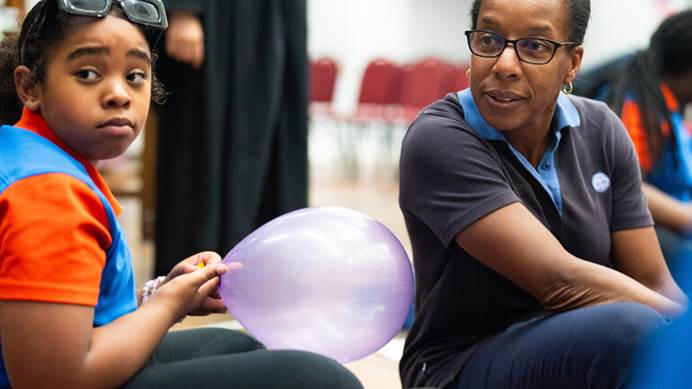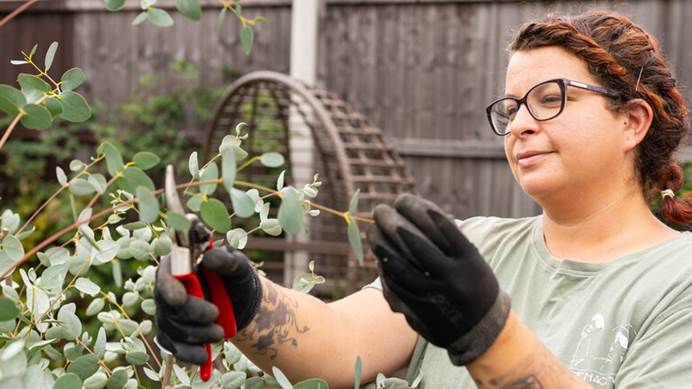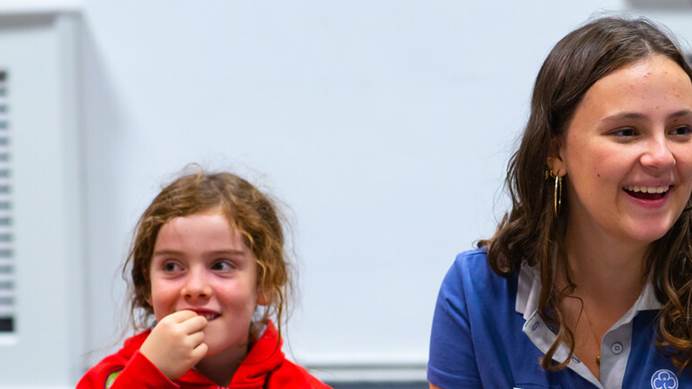Working with young volunteers
Support and guidance for including young volunteers as part of your unit team
We've updated our offer for young leaders with a new young leader development programme. Check out our guidance notes for leaders to help you support the young leaders in your unit.
They inspire your girls and you. Our young volunteers make such a difference to the Girlguiding community.
Our young volunteers include:
- Rainbow and Brownie helpers: Guides aged 10-14 helping with a unit
- Young leaders: members aged 14-17 who volunteer with a unit
- Young external volunteers: young people aged 13-17 who help with a unit for the volunteering section of an external award, like the Duke of Edinburgh’s Award.
- Peer educators: members aged 14-25 who have been trained to deliver our peer education resources to units in their local area.
Remember that none of these young volunteers should be left alone or in charge of the unit.
Supporting your young volunteers
Before they join as a helper
- It can be tricky for a Guide to return immediately to their previous Brownie unit as a helper. We recommend a short break of at least half a term before they return as a helper.
- Remember to think about your ratios with Rainbow or Brownie helpers as they count towards the children in your unit.
Starting out
- Take them through the basics of your unit, like fire escapes, bathrooms and where everything lives , even if they were part of the unit as a Rainbow or Brownie.
- They need to understand safety and safeguarding for their role. There are fun activity sheets to take them through what they need to know.
- You’ll need to add your Rainbow or Brownie helper to your young members tab on GO. You’ll find the helper list at the bottom of the page, below your list of young members. They should be added to your unit on GO to make sure they appear on your unit’s emergency contact list.
- There is a special badge available which you can give to your Rainbow or Brownie helper. Buy the Rainbow helper badge or the Brownie helper badge.
Being a Rainbow or Brownie helper
There are many ways Guides aged 10-14 can help in your unit. Find examples on the Rainbow or Brownie helpers page.
You’ll need to chat through the role and what being in a leadership role means for them. This could include:
- What to do if they hear things about the other girls they need to keep confidential.
- Avoiding working too closely with the Brownies they’re good friends with. We suggest they work with the new or younger Brownies instead.
- A reminder that they are there to help, not just to take part in the activities.
When you give helpers things to do, make sure you give them support to prepare for and carry out the task. Take time afterwards to talk through how it went.
Use a day events and activities information and consent form for Rainbow and Brownie helpers for any activities away from the meeting place that they take part in with your unit.
Their progression
Once they turn 14, if they want to continue volunteering, talk to them about becoming a young leader after they finish Guides.
The Rainbow and Brownie helper role is linked to the young member’s Guide role. If they leave Guides, they cannot continue as a Rainbow or Brownie helper.
Before they join as a young leader
- It may be tricky for a young leader to return immediately to their previous Guide unit, so we recommend a short break before they return. Half a term is normally enough.
- Young leaders are not included in your ratios, but they’re not adults. You still need to make sure you have enough adults to cover your meetings when they join.
Starting out
- Make sure that they’re in the right role on GO – this should be the young leader role, and any Guide roles should be ended. Ask to your local commissioner to add them as a young leader with your unit.
- They’ll need to have their GO profile set up with their own email address or they won’t be able to login to GO or the learning platform.
- Use the new starter form for young members aged 14-17 for all young leaders joining your unit, even if they are already on GO. This means that the young leader and their parent have important information about their role and your unit.
- Share the young leader welcome leaflet with them to give them an introduction to your unit and help them set goals, complete tasks and reflect on their first term. The young leader welcome leaflet can be printed out or completed online. It’s designed to give new young leaders an introduction to their role and help to build their confidence and begin to develop key leadership skills.
- Ask them to do the 14-17 a safe space e-learning and check in with them afterwards to make sure they understand their role in keeping themselves and others safe.
- Make sure they know the unit risk assessment.
- Once they have completed the welcome leaflet, you can reward them with a special I take the lead woven badge.
Being a young leader
Find out how young leaders can get involved.
They can choose to work on the young leader development programme to develop their skills, grow their knowledge and celebrate their achievements.
Find out more about the young leader development programme.
Make sure that you have a chat about the role and what being a young leader means. Let them know:
- They might hear things about the other girls they need to keep confidential.
- They are there to help, not just to take part in the activities.
- They should be thoughtful in the way they communicate and keep in mind the age and abilities of the girls they are leading.
- If they're returning to their previous Guide unit, they should avoid working too closely with the Guides they’re good friends with. They could work with the new or younger Guides instead.
- If they have the phone number of friends who are still Guides, they need to make sure they’re thoughtful about their communications in a guiding context. They shouldn’t be getting the mobile phone numbers of new or younger Guides.
- They shouldn’t start romantic relationships with Guides.
- They can make their promise as a young leader and receive a young leader Promise badge.
- They can wear special young leader uniform, or if they are also a Ranger, they can wear their Ranger uniform.
Use a day events and activities information and consent form for young leaders for any activities away from the meeting place that they take part in with your unit.
Their progression
When they’re coming up to their 18th birthday, have a chat with them about what role they’d like to take on as an adult. On GO, their young leader role will automatically end when they're 18, and they'll be given a unit helper role. Make sure you tell your commissioner if they want to be a leader-in-training instead. Remind the young leader that their local commissioner will contact them to organise a disclosure check and that they’ll need to complete the adult safer guiding on the learning platform once they've turned 18.
If you have a residential coming up, you might need a disclosure check earlier than that. You can contact the membership systems team for help.
Depending on the volunteering needed for their award, these young people can volunteer for 3 to 18 months. In that short time they can make a huge difference in your unit. Remember, this role is for people of all genders.
Starting out
- They can start at 13 so you can contact them if they’ve signed up at that age. Use our digital safeguarding procedures to help contact them. They might have been a Rainbow, Brownie or Guide, so your local commissioner can use their membership number or name and date of birth to find their previous record and add them to your unit.
- They’ll probably know less about guiding than people who are already young members. They might not know what the Promise is or any of our traditions, for example. It’s great to walk them through their first unit meeting or give them a taster to see if they like it.
- When they start you’ll need to use the external volunteer starter form for 13-year-olds for 13 year olds, or the new starter form for 14- to 17-year-olds for anyone in that age range. This means that the young volunteer and their parent have important information about their role and your unit.
- Share the young volunteer welcome leaflet with them to give them an introduction to your unit and help them to set goals, complete the tasks and reflect on their volunteering experience. The young volunteer welcome leaflet can be printed out or completed online. It’s designed to give new young volunteers an introduction to their role and help them to develop the key skills needed to be an effective member of the unit team.
- 13-year-olds won’t be able to log into GO to check their own details, and they do a separate different safe space training. They can still complete the rest of the leaflet.
- They’ll need to have their GO profile set up with their own email address if they’re 14 or over or they won’t be able to login to GO or the learning platform.
- Ask them to complete the required a safe space training depending on their age. 14-17 year old’s can complete the a safe space e-learning for 14- to 17-year-olds. For those aged 13, there's a special activity sheet instead.
- These young volunteers can do similar things to young leaders. The big difference is that they might not be here as long, so may not be able to build up their skills and confidence as much. They're also not members, and don’t make a Promise.
- Once they have completed the welcome leaflet, you can reward them with a special I take the lead woven badge.
- They can also complete modules in the young leader development programme, especially if they are volunteering for longer than 3 months.
Young external volunteers doing their Duke of Edinburgh's Award
- All Duke of Edinburgh award volunteers will need to set themselves goals. These can be crossovers to the Girlguiding offer, like completing the welcome leaflet, or some of the modules in the young leader development programme, or they can be more informal, like learning to plan and run an activity from scratch. Make sure you know how long they plan to volunteer and help them to set realistic goals.
- At the end of their volunteering time, you’ll need to write a short assessors report on what the DofE volunteers have done. The young person should let you know what format this needs to be in and how to submit it. The DofE have created some guidance to help you to write the assessors report.
Use a day events and activities information and consent form for any activities away from the meeting place that they take part in with your unit.
Their progression
Once they’ve had a taster of Girlguiding, some might want to become full members. Introduce them to the young leader role, if they’re a girl, and help them decide if they want to make their Promise and get involved in some of Girlguiding’s fantastic opportunities.
Young people can hold the role of young external volunteer for up to 2 years. if they need to volunteer for a longer period, this role can be extended for another 2 years.
If they turn 18 while volunteering, they’ll need to have their role changed to unit helper by the local commissioner and complete a disclosure check.
Anyone over 18 who wants to volunteer with Girlguiding as part of an external award should be given the role of unit helper, and go through the adult recruitment process.
These facilitators are members aged 14-25. They’ve been specially trained to deliver age appropriate sessions with Brownies, Guides and Rangers, tackling topics like mental wellbeing, challenging gender stereotypes and personal safety.
Find out more about peer education.
If you have a peer educator coming to deliver a session with your unit, there are a couple of things to think about:
Before the session
- The peer educator will want to have a chat with you about the unit (people and space), the session and the activities. Use our digital safeguarding procedures to keep in contact with anyone under 18. A Zoom call with another leader or their coordinator is the best way to do this safely.
- Adult peer educators don’t get a disclosure check for this role, so make sure you use the visitor’s checklist if they don’t have another adult role in guiding.
- It’s always okay to ask if their safer guiding is in date. They need to have completed safer guiding, or a safe space for 14-17-year-olds if they’re under 18.
- They’ll ask you to do a pre-session evaluation, so they can establish a baseline and see how effective their session is. This is usually a questionnaire.
During and after the session
- You’ll need to remain in place for the whole session, and support with any behavioural issues.
- The peer educator will raise any safeguarding concerns with you but will also report it on their post-session log, so the HQ safeguarding team may get in touch with helpful resources.


